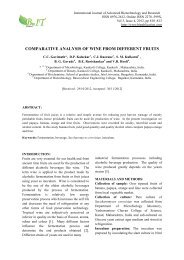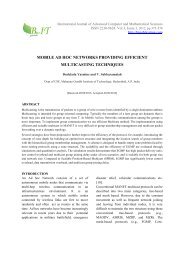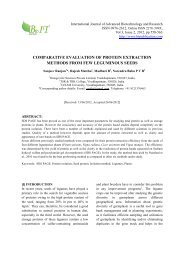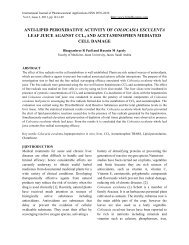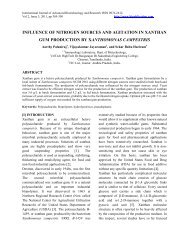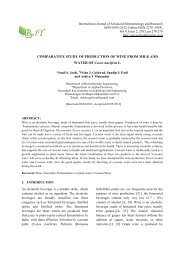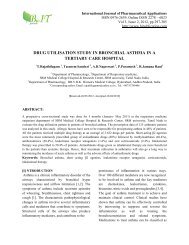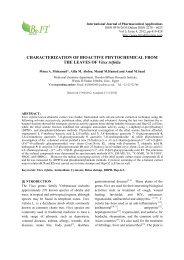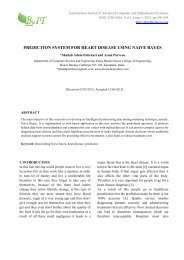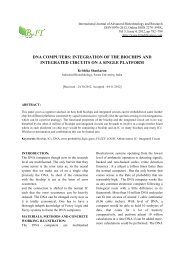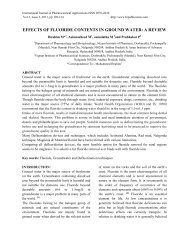431-436 - BioIT international Journals
431-436 - BioIT international Journals
431-436 - BioIT international Journals
You also want an ePaper? Increase the reach of your titles
YUMPU automatically turns print PDFs into web optimized ePapers that Google loves.
SOME ANGIOSPERMIC PARASITIC PLANT FROM NARNALA FORT<br />
alternate, variable in shape, leathery, oblong,<br />
obtuse with cuneate at the base. Flowers<br />
orange in axillary raceme, bracts minute,<br />
ovate. Calyx tomentose, shortly five lobed.<br />
Corolla tube curved, lobes five, reflexed.<br />
Stamens exerted. Style quadrangular, stigma<br />
knob shaped. Fruit berry 1 cm long, black,<br />
when riped, oblong.<br />
Ethnomedicinal significance:<br />
Bark of this plant is used in impotency by<br />
Gond tribes. Korku tribes applied juice in<br />
leucoderma and other skin infection. Korku<br />
tribes also use the decoction of bark in<br />
asthma and to regulate menstrual cycle in<br />
women.<br />
5. Santalum album L.<br />
Family: SANTALACEAE<br />
Vern. Name : Safed Chandan (H), Chandan<br />
exserted. Fruit drupe, globose, purpleblack.<br />
(The yellowish-brown strongly- scented heart<br />
wood constitute the well-known sandal<br />
wood).<br />
Ethnomedicinal significance:<br />
Leaf extract of this plant used in dysentery by<br />
the local tribes. Wood-ground up with water<br />
into paste applied to the temples in headache,<br />
fever and local inflammation and in skin<br />
diseases. Wood also used in bilious fever.<br />
6.Striga gesnerioides<br />
Family:SCROPHULARIACE<br />
Varn.Name: : cowpea witchweed, tobacco<br />
(M).<br />
Locality : Narnala Fort<br />
Habitat : Common in forest, also planted in<br />
gardens.<br />
Description :<br />
A glabrous perennial everygreen small trees<br />
with drooping branches, bark smooth<br />
aromatic. Leaves simple, alternate,<br />
lanceolate, acute, entire, petiolate, shining.<br />
Flowers small in axillary pedunculate cyme,<br />
greenish, crimson, inodorous, perianth<br />
campanulate with 4 valvate segment, disc,<br />
lobed and thick. Stamen 4 polyandrous,<br />
witchweed<br />
Locality: Narnala fort<br />
Habitat: parasitizes on sorghum, sugarcane,<br />
rice, legumes<br />
Description:<br />
S. gesnerioides of typical Scrophulariaceous<br />
form, are borne in opposite pairs or<br />
alternately in a terminal leafy inflorescence.<br />
The underground part of the stem is purple,<br />
cylindrical, somewhat thicker than the aerial<br />
part and 2.5-7.5 cm long. The roots are white<br />
and closely attached to the host roots by<br />
haustoria .<br />
Ethnomedicinal significance:<br />
The sap of Srtiga gesnerioides is used to dye<br />
skins blue-blank in mali.<br />
Pranjali J. Deshmukh 434



